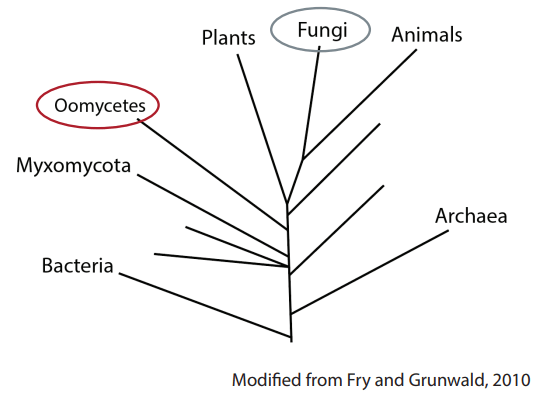Differences in Managing the Mildews
Chemical Control
A common misconception, which can be extremely detrimental to an effective spray program is that all fungicides will work on both downy mildew and powdery mildew.
Why isn’t this the case?
Downy mildew is NOT a fungus. It belongs to a different group of fungus-like organisms called “Oomycetes” (right). Powdery mildew IS a true fungus, belonging to the kingdom “Fungi” (right). The term “fungicide” is misleading since some fungicides are designed to work on fungi and some to work on oomycetes. Most modern fungicide formulations have a single, highly specific target site in the organisms they control. Since they belong to Modified from Fry and Grunwald, 2010, completely different kingdoms, rarely will an oomycete possess the same specific site inside its cell as the site being targeted by a fungicide designed to control a fungus or vice versa. Just as you would not expect an antibacterial drug to work on a fungus, RARELY will a fungicide designed to work on Fungi will also work well against Oomycetes. An exception are some strobilurin-based formulations, such as Flint and Pristine, which can provide moderate suppression of downy mildew when primarily used for powdery mildew control.
Why does this matter?
Properly differentiating whether downy mildew or powdery mildew is present in your yard is crucial to controlling either of these diseases. For example, in mid-season, you notice infections on your leaves are that diagnosed as powdery mildew but actually were downy mildew. Your solution would be to spray a fungicide designed to control powdery mildew. So you choose a DMI fungicide, such as Rally, which can be great against fungi like powdery mildew, but has no efficacy against oomycetes, such as downy mildew. Since in reality, there was downy mildew present in your yard, this fungicide spray unfortunately would do nothing to help control the disease. Correctly diagnosing disease in your yard is important when it comes to successful management, which applies to all diseases, not just powdery and downy mildew. When considering fungicides, it is imperative to recognize that the two classes of organisms exist (Fungi and Oomycetes), and appropriate fungicides can vary based on the organism you are trying to control.
More information: The 2017 Cornell Integrated Hops Production Guide, Michigan State Registered Pesticide Guide for Hops 2016, and the Pacific Northwest Pest Management Handbook – Hops all have region specific pesticide information.
Similarities in Managing the Mildews
Cultural Practices
Most of the major cultural practices occur during the early to mid-season growth of your hop. Overall, these strategies are designed to limit the initial amount of disease in your yard each season, and make the hop yard environment less favorable for disease.
Pruning: Both downy mildew (as basal spikes) and powdery mildew (as flagshoots) can overwinter and emerge on the early batches of hop buds that break ground. The first batch of hop growth can be cut back, either chemically or manually, to eliminate as much hop foliage harboring either overwintered pathogen. Each variety typically has it’s own pruning timing based on vigor, and no variety should be pruned in the first year. There are also seasonal aspects that come into play such as cold weather, in which pruning timing should be pushed forward, or skipped altogether to account for slower growth of shoots in the cold.
Training Shoots: Shoots should be trained as soon as they are tall enough to reach the strings. Once 3-4 vigorous shoots have been trained to each string, the remaining basal foliage should be cut back to reduce the amount of hop plant material resting on the soil, where moisture and humididty levels are highest and conditions are optimal for disease.
Stripping Lower Leaves: Once bines have reached a height of about 8 feet, the lower 4 feet of leaves can be stripped by hand or with an herbicide (right). This improves airfow in the lower sections of the yard, reducing humidity at ground level and breaking the bridge of green hop tissue spanning hill to hill. Stripping leaves should not be done the first year, and some aromatic varieties with a low alpha acids precentage are less tolerant of this practice.
Authors: Bill Weldon, Dave H. Gent, David M. Gadoury – November 2017